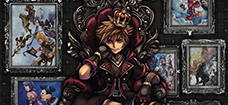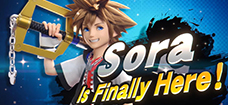|
Kando: We began planning around two and a half years ago.
Arakawa: Right.
Kando: Before the DS went on sale.
Hasegawa: We began without seeing the handheld yet.
Kando: We’ve been working so hard that it’s hard to believe it’s already been two and a half years (laugh).
Arakawa: How did it all begin? I wasn’t in the team from the beginning.
Kando: This was around the time when Jupiter was finishing KINGDOM HEARTS CHAIN OF MEMORIES for the GBA. We were having talks about working together again and were planning some ideas, and then we got an offer from [KINGDOM HEARTS director] Mr. Tetsuya Nomura.
Hasegawa: We immediately started writing the script (laugh). We then decided on the setting of the world.
The World Ends with You
Kando: Since Hasegawa and I are both graphic artists, we needed help from someone experienced in planning. So we had Arakawa come in to help us. Then we went to that Nintendo DS show.
Hasegawa: The show where we got to first touch the DS. We lined up to play the games.
Kando: Touch DS.
Arakawa: When was that? Somewhere around the end of October, I guess. [Editor's Note: The event took place in November 2004.] The DS wasn’t even in stores and they told us to make a game for it (laugh).
Kando: (Laugh)
Arakawa: We said that we didn’t have one to try out and asked how we could, then we were told to go to the show (laugh).
Kando: In the end it was a great chance to try out all the neat games. It was great.
Arakawa: I remember Nintendo’s Yoshi Touch & Go. We didn’t have a DS so we attended the show two or three times. Every time I went I played it, so I became pretty good at it (laugh).
Kando: How many times did you “test play” it? (laugh)
Arakawa: The booth staff would come over and comment on how good I was (laugh).
Kando: (Laugh) And you'd be like, “it’s my third time!” (laugh)
Arakawa: I remember how I came to realize the capabilities of the DS then, thinking how amazing the touch screen was.
Hasegawa: It was really fun, getting to try out the touch screen.
Arakawa: I thought that it was awesome how I could really see what I touched do something in the game. When I first learned about the DS I had an idea that the bottom screen could be used for card games, like an extension to CHAIN OF MEMORIES. On the upper screen would be something like an action RPG. But after a while we wanted to use the touch screen for something more…
Kando: I remember your first planning documents. You had the idea of an action game that you controlled with the touch screen.
Arakawa: Right. Since we were going to be using a touch screen I thought that we should go in this direction, but we didn’t even know the technical limitations of the touch screen yet, so we couldn’t fully rely on it. I sent my plan anyway and made revisions, went to the show again, played with the DS some more… After a while the game plan started to concentrate on the lower screen more. I felt that the game wouldn’t do the DS justice if it didn’t use the touch screen.
Kando: In the beginning the three of us kept sending game ideas and were in arguments about it.
Arakawa: Right. I remember being chewed out by Mr. Nomura. He’d say “No, we could do this on the PSP,” or something like that. The hurdle was really high from the get-go, because we set out to create “a game that can only be played on the DS.”
Hasegawa: Coming up with what to do with the two screens was the biggest challenge.
Kando: We initially thought that the player would control the game on the bottom screen and watch the action happen on the top screen, but that always made one of the screens less important.
Arakawa: Right. At the beginning, we were saying, “There’s no way we can use two screens,” but we kept playing with the idea that we could have a battle on both screens.
Kando: And that was the answer we were looking for. We shifted our thoughts to making a game that would utilize every function of the Nintendo DS, something truly worthy of the system. That’s how the dual-screen battle was born.
Arakawa: So sudden (laugh). We were like “So we’re really going to go with this idea after all.” (laugh)
Kando: The bottom screen has a battle, the top screen has a battle...
Arakawa: That sure was amazing.
Kando: But the idea wouldn’t come to you if you’re thinking in a straight-forward manner. Even if you came up with the idea, you’d dismiss it like ‘that’s just impossible.’
Hasegawa: It is impossible (laugh).
Kando: Everyone was shocked at first at the idea. They kept saying that it was impossible. Then we decided on using both screens for the battles, and from that point on, it took a long time to materialize the idea. After that my heart kept racing. It kept racing until the game was finally announced.
Arakawa: We didn’t want the game to be announced, if possible.
Kando: We knew that this was a brand new concept, so I was really afraid of someone else doing it first.
Arakawa: We kept the secret amongst ourselves for about two years (laughs). We worked real hard for the Tokyo Game Show in September. We sure conceived a lot of ideas up to that show. But we actually decided that the game would be set in Shibuya pretty early on.
Kando: That was really early. We decided by January 2005 or so.
Arakawa: We knew it was going to be set in a modern world. At first we were going to use the entire world.
Hasegawa: We first had ideas to gather cities. Like gathering the Tokyo Tower or the Sphinx. Then, we wanted to get some source materials for inspiration, but we couldn’t go to Egypt (laugh).
Kando: So essentially the game’s world was shrunk down.
Hasegawa: Mr. Kando one day just told us that we’re going with Shibuya and Shibuya only (laugh). That we’re going to make a game that completely remakes Shibuya.
Arakawa: Quality over quantity, making one thing solid.
Kando: We first thought of including cities that could be reached with the Yamanote Line train and travel around known cities, but then we decided to concentrate it down to one spot. Shibuya has an image as a melting pot, so we thought that we could stage the entire game world in Shibuya. We also thought that it’d be easier to tell a story this way as well, so we stuck with Shibuya.
Hasegawa: I was unsure about it at first, but once the playing field was decided and being made, I felt that it was realistic. We knew from the beginning that the game would be in 2D, and even in such a limited state we were asked to recreate Shibuya faithfully. That’s when I saw the game in my head. I felt then that this game, with its dual-screen battles and the setting in Shibuya, would not have a heavy, epic story. I rather felt that it would have a stoic, mystery-laden story that would keep the player guessing. Within that setting there are battles, and people meet with each other and tell a story of comradely in a realistic way. At least that’s what I imagined (laugh). I think that’s how the game turned out, though, pretty much.
|







